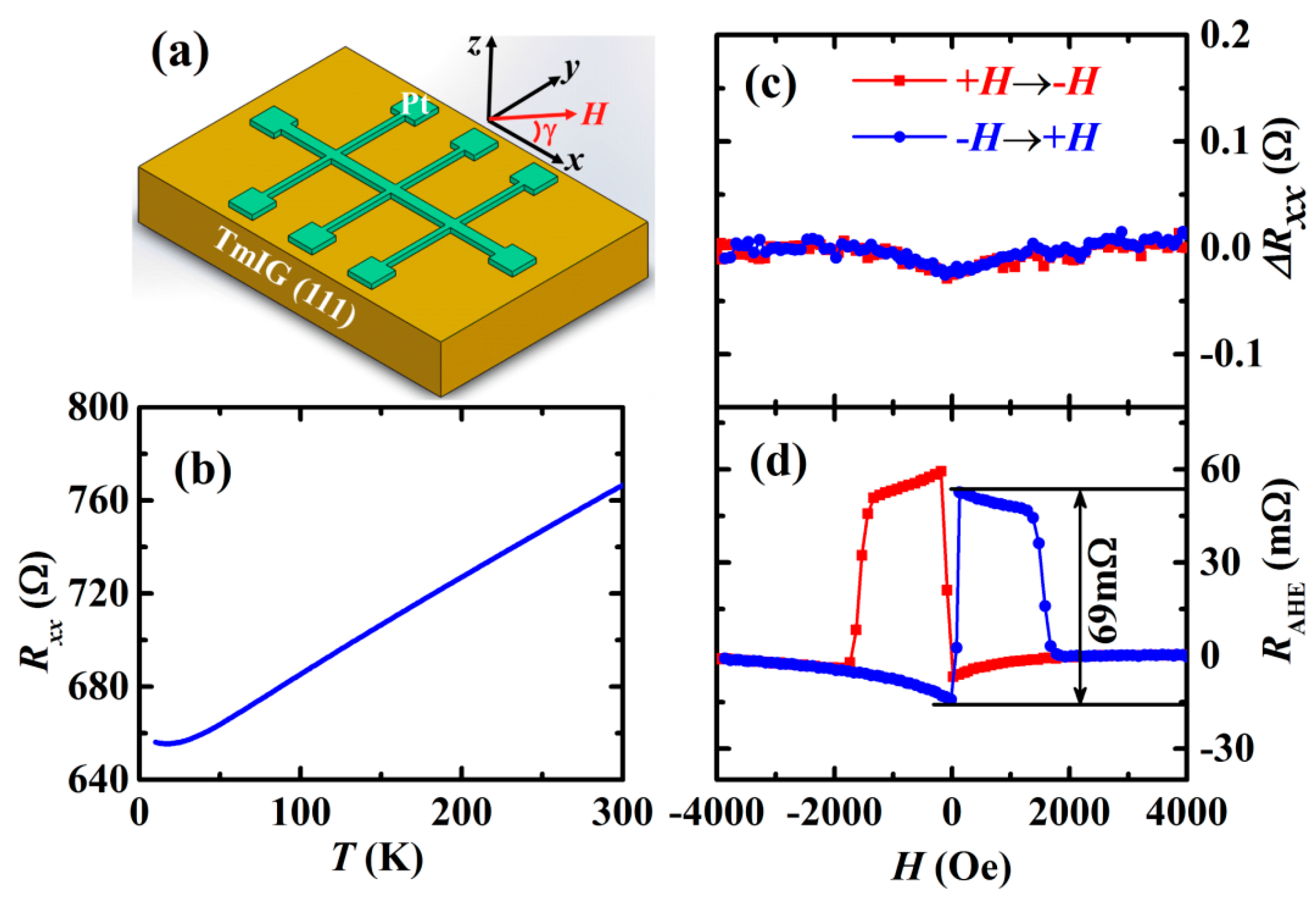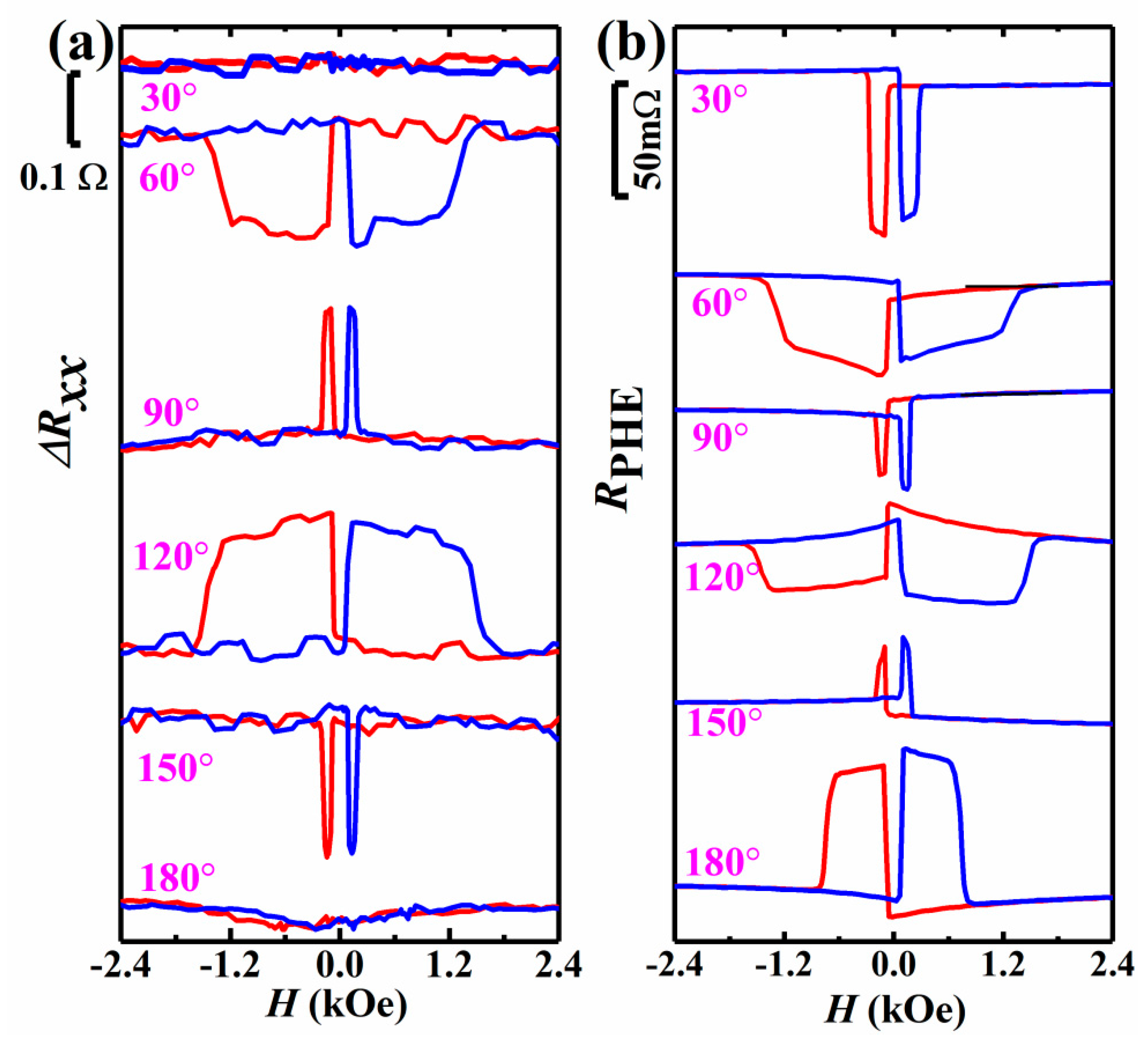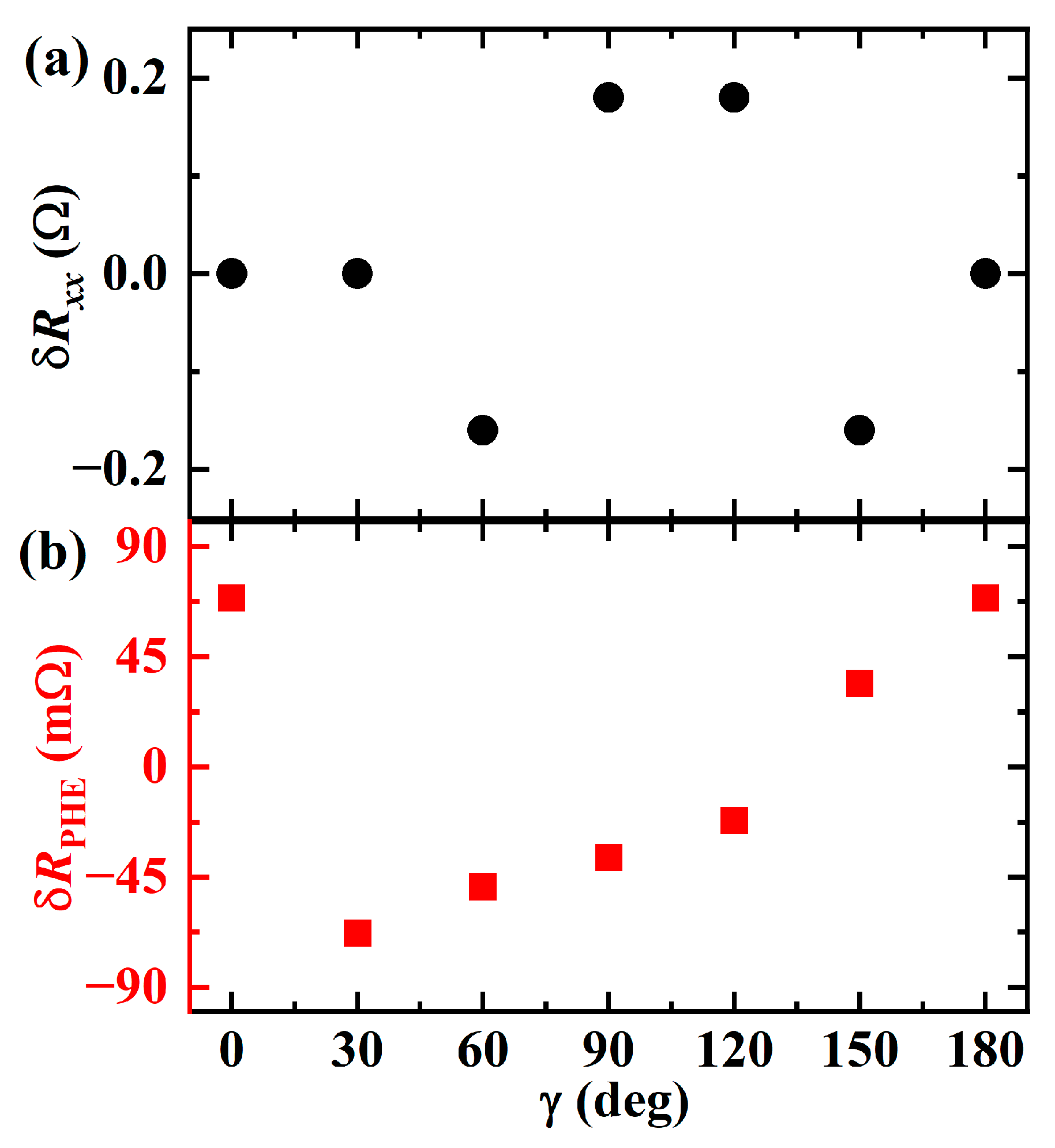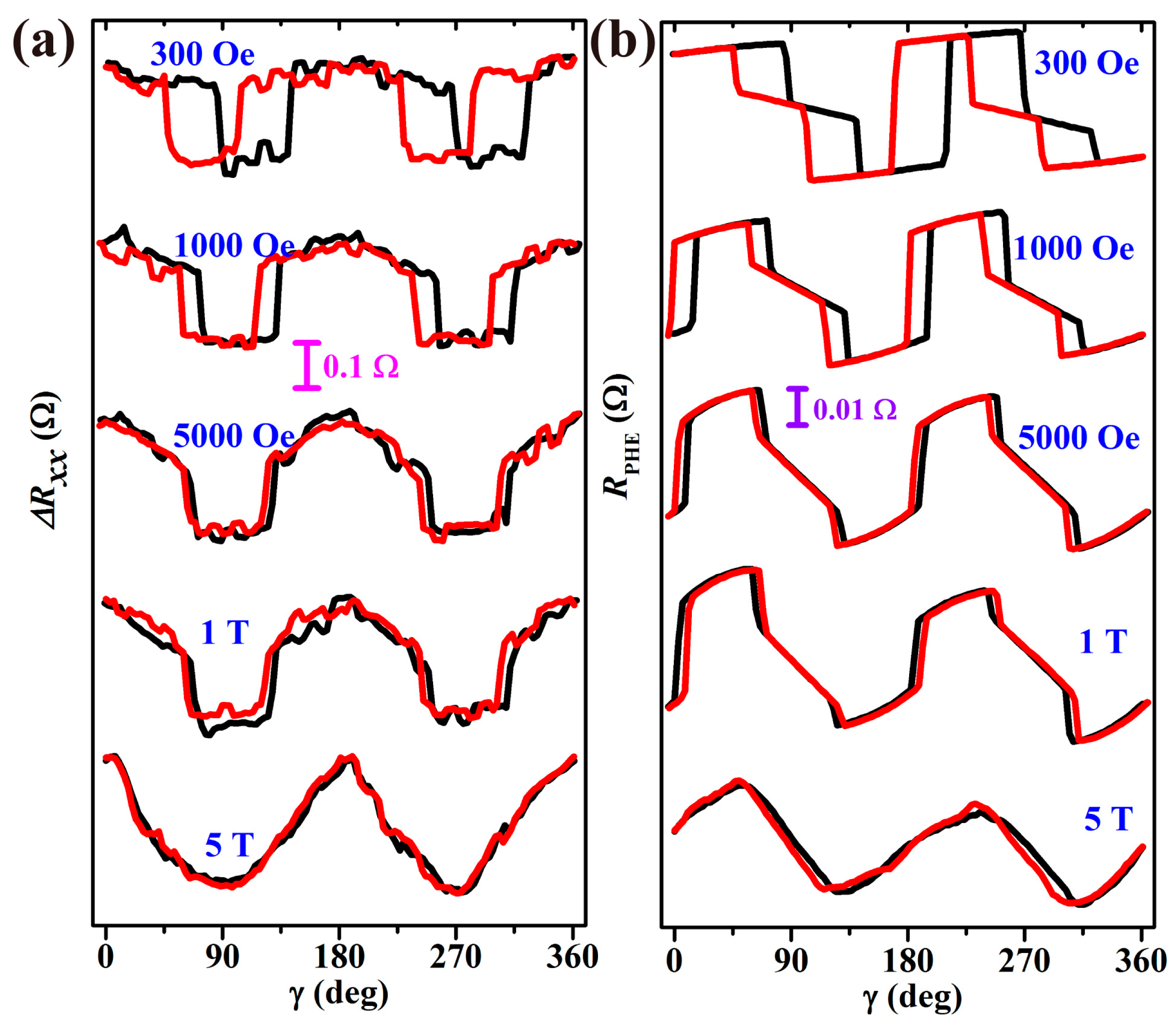Planar Hall Effect and Magnetoresistance Effect in Pt/Tm3Fe5O12 Bilayers at Low Temperature
Abstract
1. Introduction
2. Experiment
2.1. Synthesis of Pt/TmIG Heterostructures
2.2. Transport Measurements of Pt/TmIG Heterostructures
3. Results and Discussion
3.1. Magnetotransport of Pt/TmIG Heterostructures at 10 K
3.2. Angular Dependence of the Magnetotransport of Pt/TmIG Heterostructures
4. Conclusions
Author Contributions
Funding
Data Availability Statement
Conflicts of Interest
References
- Zutic, I.; Fabian, J.; Sarma, S.D. Spintronics: Fundamentals and Applications. Rev. Mod. Phys. 2004, 76, 323. [Google Scholar] [CrossRef]
- Fukami, S.; Ohno, H.; Zhang, C.; DuttaGupta, S.; Kurenkov, A. Magnetization Switching by Spin–Orbit Torque in an Antiferromagnet–Ferromagnet Bilayer System. Nat. Mater. 2016, 15, 535. [Google Scholar] [CrossRef]
- Ko, T.W.; Park, B.K.; Lee, J.H.; Rhie, K.; Kim, M.Y.; Rhee, J.R. Planar Hall Effect of Glass/Fe 70 Å/[Co 21Å/Cu 25Å ]20 Multilayers. J. Magn. Magn. Mater. 1999, 198, 64–66. [Google Scholar] [CrossRef]
- Adeyeye, A.O.; Win, M.T.; Tan, T.A.; Chong, G.S.; Ng, V.; Low, T.S. Planar Hall Effect and Magnetoresistance in Co/Cu Multilayer Films. Sens. Actuators A Phys. 2004, 116, 95–102. [Google Scholar] [CrossRef]
- Montaigne Fo Schuhl, A.; Dau, F.N.V.; Encinas, A. Development of Magnetoresistive Sensors Based on Planar Hall Effect for Applications to Microcompass. Sens. Actuators A Phys. 2000, 81, 324. [Google Scholar] [CrossRef]
- Tang, H.X.; Kawakami, R.K.; Awschalom, D.D.; Roukes, M.L. Giant Planar Hall Effect in Epitaxial (Ga, Mn) as Devices. Phys. Rev. Lett. 2003, 90, 107201. [Google Scholar] [CrossRef]
- Bason, Y.; Klein, L.; Yau, J.B.; Hong, X.; Ahn, C.H. Giant Planar Hall Effect in Colossal Magnetoresistive La0.84sr0.16mno3 Thin Films. Appl. Phys. Lett. 2004, 84, 2593–2595. [Google Scholar] [CrossRef]
- Seemann, K.M.; Freimuth, F.; Zhang, H.; Blugel, S.; Mokrousov, Y.; Burgler, D.E.; Schneider, C.M. Origin of the Planar Hall Effect in Nanocrystalline Co60fe20b20. Phys. Rev. Lett. 2011, 107, 086603. [Google Scholar] [CrossRef]
- Shin, J.; Kim, S.; Lee, S.; Yoo, T.; Lee, H.; Khym, S.; Lee, S.; Liu, X.; Furdyna, J.K. Asymmetry in the Angular Dependence of the Switching Field of Gamnas Film. J. Appl. Phys. 2011, 109, 07C308. [Google Scholar] [CrossRef]
- Thompson, D.A.; Romankiw, L.T.; Mayadas, A.F. Thin Film Magnetoresistors in Memory, Storage, and Related Application. IEEE Trans. Magn. 1975, 11, 1039. [Google Scholar] [CrossRef]
- Garello, K.; Miron, I.M.; Avci, C.O.; Freimuth, F.; Mokrousov, Y.; Blugel, S.; Auffret Sp Boulle, O.; Gaudin, G.; Gambardella, P. Symmetry and Magnitude of Spin—Orbit Torques in Ferromagnetic Heterostructures. Nat. Nanotechnol. 2013, 8, 587. [Google Scholar] [CrossRef]
- Fan, X.; Wu, J.; Chen, Y.; Jerry, M.J.; Zhang, H.; Xiao, J.Q. Observation of the Nonlocal Spin-Orbital Effective Field. Nat. Commun. 2013, 4, 1799. [Google Scholar] [CrossRef] [PubMed]
- Yokouchi, T.; Kanazawa, N.; Tsukazaki, A.; Kozuka, Y.; Kikkawa, A.; Taguchi, Y.; Kawasaki, M.; Ichikawa, M.; Kagawa, F.; Tokura, Y. Formation of in-Plane Skyrmions in Epitaxial Mnsi Thin Films as Revealed by Planar Hall Effect. J. Phys. Soc. Jpn. 2015, 84, 104708. [Google Scholar] [CrossRef]
- Kong, W.J.; Ji, Y.R.; Zhang, X.; Wu, H.; Zhang, Q.T.; Yuan, Z.H.; Wan, C.H.; Han, X.F.; Yu, T.; Fukuda, K.; et al. Field-Free Spin Hall Effect Driven Magnetization Switching in Pd/Co/Irmn Exchange Coupling System. Appl. Phys. Lett. 2016, 109, 132402. [Google Scholar] [CrossRef]
- Nakayama, H.; Althammer, M.; Chen, Y.T.; Uchida, K.; Kajiwara, Y.; Kikuchi, D.; Ohtani, T.; Geprags, S.; Opel, M.; Takahashi, S.; et al. Spin Hall Magnetoresistance Induced by a Nonequilibrium Proximity Effect. Phys. Rev. Lett. 2013, 110, 206601. [Google Scholar] [CrossRef]
- Wang, H.L.; Du, C.H.; Pu, Y.; Adur, R.; Hammel, P.C.; Yang, F.Y. Scaling of Spin Hall Angle in 3d, 4d, and 5d Metals from Y3fe5o12/Metal Spin Pumping. Phys. Rev. Lett. 2014, 112, 197201. [Google Scholar] [CrossRef] [PubMed]
- Aldosary, M.; Li, J.; Tang, C.; Xu, Y.; Zheng, J.-G.; Bozhilov, K.N.; Shi, J. Platinum/Yttrium Iron Garnet Inverted Structures for Spin Current Transport. Appl. Phys. Lett. 2016, 108, 242401. [Google Scholar] [CrossRef]
- Li, J.; Xu, Y.; Aldosary, M.; Tang, C.; Lin, Z.; Zhang, S.; Lake, R.; Shi, J. Observation of Magnon-Mediated Current Drag in Pt/Yttrium Iron Garnet/Pt(Ta) Trilayers. Nat. Commun. 2016, 7, 10858. [Google Scholar] [CrossRef]
- Avci, C.O.; Quindeau, A.; Pai, C.F.; Mann, M.; Caretta, L.; Tang, A.S.; Onbasli, M.C.; Ross, C.A.; Beach, G.S. Current-Induced Switching in a Magnetic Insulator. Nat. Mater. 2017, 16, 309–314. [Google Scholar] [CrossRef]
- Liu, Y.K.; Wong, H.F.; Lam, K.K.; Chan, K.H.; Mak, C.L.; Leung, C.W. Anomalous Hall Effect in Pt/Tb3fe5o12 Heterostructure: Effect of Compensation Point. J. Magn. Magn. Mater. 2018, 468, 235–240. [Google Scholar] [CrossRef]
- Geller, S.; Remeika, J.P.; Sherwood, R.C.; Williams, H.J.; Espinosa, G.P. Magnetic Study of the Heavier Rare-Earth Iron Garnets. Phys. Rev. 1965, 137, A1034–A1038. [Google Scholar] [CrossRef]
- Lehmann-Szweykowska, A.; Wigen, P.E.; Kowalewski, L.; Kaczmarek, M.M.; Mitchell, T.B. Orbital Effects in Magnetic Dynamics of Thulium Iron Garnets. Phys. Rev. B 1988, 37, 459–466. [Google Scholar] [CrossRef]
- Lu, Y.M.; Choi, Y.; Ortega, C.M.; Cheng, X.M.; Cai, J.W.; Huang, S.Y.; Sun, L.; Chien, C.L. Pt Magnetic Polarization on Y3fe5o12 and Magnetotransport Characteristics. Phys. Rev. Lett. 2013, 110, 147207. [Google Scholar] [CrossRef]
- Shin, D.Y.; Chung, S.J.; Lee, S.; Liu, X.; Furdyna, J.K. Temperature Dependence of Magnetic Anisotropy in Ferromagnetic (Ga,Mn)as Films: Investigation by the Planar Hall Effect. Phys. Rev. B 2007, 76, 035327. [Google Scholar] [CrossRef]
- Fernández-Pacheco, A.; De Teresa, J.M.; Orna, J.; Morellon, L.; Algarabel, P.A.; Pardo, J.A.; Ibarra, M.R.; Magen, C.; Snoeck, E. Giant Planar Hall Effect in Epitaxialfe3o4thin Films and Its Temperature Dependence. Phys. Rev. B 2008, 78, 212402. [Google Scholar] [CrossRef]
- Geprags, S.; Kehlberger, A.; Della Coletta, F.; Qiu, Z.; Guo, E.J.; Schulz, T.; Mix, C.; Meyer, S.; Kamra, A.; Althammer, M.; et al. Origin of the Spin Seebeck Effect in Compensated Ferrimagnets. Nat. Commun. 2016, 7, 10452. [Google Scholar] [CrossRef] [PubMed]
- Miao, G.-X.; Münzenberg, M.; Moodera, J.S. Tunneling Path toward Spintronics. Rep. Prog. Phys. 2011, 74, 036501. [Google Scholar] [CrossRef]
- Dionne, G.F.; Tumelty, P.F. Molecular-Field Coefficients of Tm3fe5o12. J. Appl. Phys. 1979, 50, 8257–8258. [Google Scholar] [CrossRef]
- Davis, D.D.; Bozorth, R.M. Magnetic Properties of Thulium Metal. Phys. Rev. 1960, 118, 1543–1545. [Google Scholar] [CrossRef]
- Bernasconi, J.; Kuse, D. Canted Spin Phase in Gadolinium Iron Garnet. Phys. Rev. B 1971, 3, 811–815. [Google Scholar] [CrossRef]
- Soares, C.C.; Mori, T.J.A.; Béron, F.; Moodera, J.S.; Cezar, J.C.; Brandão, J.; Vilela, G. Compensation-Like Temperature and Spin-Flip Switch in Strained Thulium Iron Garnet Thin Films: Tuning Sublattice Interactions for Ferrimagnetic Spintronics†. ACS Appl. Nano Mater. 2025, 8, 14567–14575. [Google Scholar] [CrossRef]
- Damerio, S.; Sunil, A.; Janus, W.; Mehraeen, M.; Zhang, S.S.L.; Avci, C.O. Magnetoresistive Detection of Perpendicular Switching in a Magnetic Insulator. Commun. Phys. 2024, 7, 114. [Google Scholar] [CrossRef]
- Nunley, T.N.; Guo, S.; Chang, L.-J.; Lujan, D.; Choe, J.; Lee, S.-F.; Yang, F.; Li, X. Quantifying Spin Hall Topological Hall Effect in Ultrathin Tm3fe5o12/Pt Bilayers. Phys. Rev. B 2022, 106, 014415. [Google Scholar] [CrossRef]
- Althammer, M.; Meyer, S.; Nakayama, H.; Schreier, M.; Altmannshofer, S.; Weiler, M.; Huebl, H.; Geprags, S.; Opel, M.; Gross, R.; et al. Quantitative Study of the Spin Hall Magnetoresistance in Ferromagnetic Insulator/Normal Metal Hybrids. Phys. Rev. B 2013, 87, 224401. [Google Scholar] [CrossRef]






Disclaimer/Publisher’s Note: The statements, opinions and data contained in all publications are solely those of the individual author(s) and contributor(s) and not of MDPI and/or the editor(s). MDPI and/or the editor(s) disclaim responsibility for any injury to people or property resulting from any ideas, methods, instructions or products referred to in the content. |
© 2025 by the authors. Licensee MDPI, Basel, Switzerland. This article is an open access article distributed under the terms and conditions of the Creative Commons Attribution (CC BY) license (https://creativecommons.org/licenses/by/4.0/).
Share and Cite
Liu, Y.; Liang, J.; Xu, Z.; Li, J.; Ruan, J.; Ng, S.M.; Huang, C.; Leung, C.W. Planar Hall Effect and Magnetoresistance Effect in Pt/Tm3Fe5O12 Bilayers at Low Temperature. Electronics 2025, 14, 3060. https://doi.org/10.3390/electronics14153060
Liu Y, Liang J, Xu Z, Li J, Ruan J, Ng SM, Huang C, Leung CW. Planar Hall Effect and Magnetoresistance Effect in Pt/Tm3Fe5O12 Bilayers at Low Temperature. Electronics. 2025; 14(15):3060. https://doi.org/10.3390/electronics14153060
Chicago/Turabian StyleLiu, Yukuai, Jingming Liang, Zhiyong Xu, Jiahui Li, Junhao Ruan, Sheung Mei Ng, Chuanwei Huang, and Chi Wah Leung. 2025. "Planar Hall Effect and Magnetoresistance Effect in Pt/Tm3Fe5O12 Bilayers at Low Temperature" Electronics 14, no. 15: 3060. https://doi.org/10.3390/electronics14153060
APA StyleLiu, Y., Liang, J., Xu, Z., Li, J., Ruan, J., Ng, S. M., Huang, C., & Leung, C. W. (2025). Planar Hall Effect and Magnetoresistance Effect in Pt/Tm3Fe5O12 Bilayers at Low Temperature. Electronics, 14(15), 3060. https://doi.org/10.3390/electronics14153060





